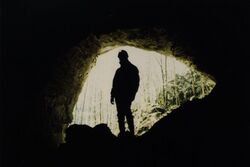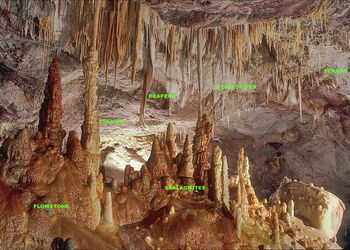Earth:Speleology
Speleology (from grc σπήλαιον (spḗlaion) 'cave', and -λογία (-logía) 'study of') is the scientific study of caves and other karst features, as well as their composition, structure, physical properties, history, ecology, and the processes by which they form (speleogenesis) and change over time (speleomorphology). The term speleology is also sometimes applied to the recreational activity of exploring caves, but this is more properly known as caving, potholing (British English), or spelunking (United States and Canadian English). Speleology and caving are often connected, as the physical skills required for in situ study are the same.
Speleology is a cross-disciplinary field that combines the knowledge of chemistry, biology, geology, physics, meteorology, and cartography to develop portraits of caves as complex, evolving systems.
History
Before modern speleology developed, John Beaumont wrote detailed descriptions of some Mendip caves in the 1680s. The term speleology was coined by Émile Rivière in 1890.[1]
Prior to the mid-nineteenth century the scientific value of caves was considered only in its contribution to other branches of science, and cave studies were considered part of the larger disciplines of geography, geology or archaeology. Very little cave-specific study was undertaken prior to the work of Édouard-Alfred Martel (1859–1938), the 'father of modern speleology', who through his extensive and well-publicised cave explorations introduced in France the concept of speleology as a distinct area of study. In 1895 Martel founded the Société de Spéléologie, the first organization devoted to cave science in the world. Other early speleologists include Herbert E. Balch.
An international speleological congress was proposed at a meeting in Valence-sur-Rhone, France in 1949 and first held in 1953 in Paris. The International Union of Speleology (UIS) was founded in 1965.[2]
The growth of speleology is directly linked with that of the sport of caving, both because of the stimulation of public interest and awareness, and the fact that most speleological field-work has been conducted by sport cavers.
Cave geology, hydrogeology and biology
Geochemistry
Speleothems
A speleothem is a geological formation by mineral deposits that accumulate over time in natural caves.[3] Speleothems most commonly form in calcareous caves due to carbonate dissolution reactions. They can take a variety of forms, depending on their depositional history and environment. Their chemical composition, gradual growth, and preservation in caves make them useful paleoclimatic proxies.
Cave cartography
The creation of an accurate, detailed map is one of the most common technical activities undertaken within a cave. Cave maps, called surveys, can be used to compare caves to each other by length, depth and volume, may reveal clues on speleogenesis, provide a spatial reference for further scientific study, and assist visitors with route-finding.
Cave biology
Caves provide a home for many unique biota. Cave ecologies are very diverse, and not sharply distinct from surface habitats. Generally however, the deeper the cave becomes, the more rarefied the ecology.
Cave environments fall into three general categories:
- Endogean
- the parts of caves that are in communication with surface soils through cracks and rock seams, groundwater seepage, and root protrusion.
- Parahypogean
- the threshold regions near cave mouths that extend to the last penetration of sunlight.
- Hypogean
- or "true" cave environments. These can be in regular contact with the surface via wind and underground rivers, or the migration of animals, or can be almost entirely isolated. Deep hypogean environments can host autonomous ecologies whose primary source of energy is not sunlight, but chemical energy liberated from limestone and other minerals by chemoautotrophic bacteria.
Cave organisms fall into three basic classes:
| Latin | English | Definition |
|---|---|---|
| Troglobites | cave dwellers | are obligatory cavernicoles, specialized for cave life. Some can leave caves for short periods, and may complete parts of their life cycles above ground, but cannot live their entire lives outside of a cave environment. Examples include chemotrophic bacteria, some species of flatworms, glowworms, collembola, and blindfish. |
| Troglophiles | cave lovers | can live part or all of their lives in caves, but can also complete a life cycle in appropriate environments on the surface. Examples include cave crickets, bats, millipedes, pseudoscorpions, and spiders. |
| Trogloxenes | cave guests | frequents caves, and may require caves for a portion of its life cycle, but must return to the surface (or a parahypogean zone) for at least some portion of its life. Hibernating reptiles and mammals are the most widely recognized examples. |
There are also so-called accidental trogloxenes which are surface organisms that enter caves for no survival reason. Some may even be troglophobes (“cave haters”), which cannot survive in caves for any extended period. Examples include deer which fell through a sinkhole, frogs swept into a cave by a flash flood, etc.
The two factors that limit cave ecologies are generally energy and nutrients. To some degree moisture is always available in actively forming Karst caves. Cut off from the sunlight and steady deposition of plant detritus, caves are poor habitats in comparison with wet areas on the surface. Most of the energy in cave environments comes from the surplus of the ecosystems outside. One major source of energy and nutrients in caves is dung from trogloxenes, most of which is deposited by bats. Other sources are mentioned above.[4]
Cave ecosystems are very fragile. Because of their rarity and position in the ecosystem they are threatened by a large number of human activities. Dam construction, limestone quarrying, water pollution and logging are just some of the disasters that can devastate or destroy underground biological communities.[5]
Other areas of cave science
Speleologists also work with archaeologists in studying underground ruins, tunnels, sewers and aqueducts, such as the various inlets and outlets of the Cloaca Maxima in Rome.[6]
See also
References
- ↑ Mattes, Johannes (2015-01-01). "Disciplinary identities and crossing boundaries: The academization of speleology in the first half of the twentieth century" (in en). Earth Sciences History 34 (2): 275–295. doi:10.17704/1944-6187-34.2.275. ISSN 0736-623X. https://meridian.allenpress.com/esh/article/34/2/275/205087/Disciplinary-identities-and-crossing-boundaries.
- ↑ "What is the UIS?". http://www.uis-speleo.org/index.php?option=com_content&view=article&id=60&Itemid=184.
- ↑ White, W.B. (2019). "Speleothems" (in en). Encyclopedia of Caves: 1006–17. doi:10.1016/B978-0-12-814124-3.00117-5. ISBN 9780128141243. https://www.sciencedirect.com/science/article/pii/B9780128141243001175.
- ↑ Dr. Paul Richter, Classifications of Cave Biota & Cave Environments (1996)
- ↑ National Speleological Society, The Fragile Underground
- ↑ Bennett, Paul (July 2006), Rome's Ruins, National Geographic Magazine, http://ngm.nationalgeographic.com/ngm/0607/feature3/, retrieved 2009-05-03
External links
- Different Types of Erosion
- National Speleological Society
- The Virtual Cave, an online guide to speleothems
- Biospeleology; The Biology of Caves, Karst, and Groundwater, by Texas Natural Science Center, the University of Texas at Austin and the Missouri Department of Conservation
- Speleogenesis Network, a communication platform for physical speleology and karst science research
- National Cave Research and Protection Organization, India
- cave-biology.org Cave biology, biospeleology in India
- Cave Biota; an evolving "webumentary", sponsored by Hoosier National Forest and Indiana Karst Conservancy
- IJS – Home Page (International Journal of Speleology) (in English, Italian, French, German, and Spanish)
- Caving News, Daily news and articles on caves, caving, speleology, karst and other information for cavers.
 |





